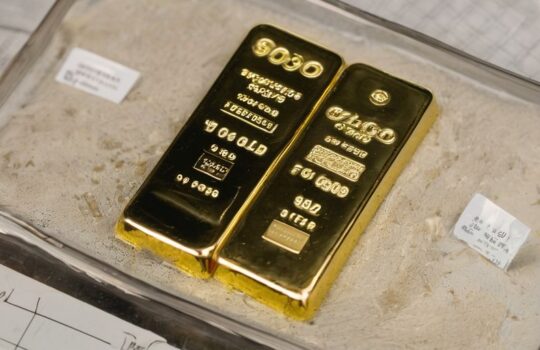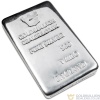Gold Price Extends Upside Amid Middle East Tensions
The price of gold has been on an upward trajectory in recent weeks, driven by escalating tensions in the Middle East. As Israel prepares to attack the Hamas group in the Gaza strip, the demand for bullion has strengthened significantly. This surge in demand can be attributed to several factors, including rising expectations of an unchanged interest rate decision by the Federal Reserve and gold's reputation as a safe-haven asset during times of geopolitical turmoil.
The Israeli government's decision to enter the Gaza strip with the goal of dismantling Hamas has sent shockwaves through the region. As news of this impending conflict spread, investors turned to gold as a hedge against potential economic instability. The precious metal has long been regarded as a reliable store of value during times of crisis, and its appeal is further enhanced when geopolitical tensions are high.
One key factor driving up the price of gold is the expectation that interest rates will remain unchanged following the Federal Reserve's meeting on November 1. The central bank's decision to maintain its current monetary policy stance has bolstered investor confidence in gold as an attractive investment option. When interest rates are low or expected to remain stable, non-yielding assets like gold become more appealing since they do not compete directly with interest-bearing investments.
Gold also tends to act as an early warning system for geopolitical trouble. It is often one of the first assets to react when tensions rise in regions such as the Middle East. Investors view gold as a safe haven due to its historical track record of preserving wealth during periods of uncertainty. As a result, any signs of conflict or political instability can trigger increased demand for gold and drive up its price.
The impact of Middle East tensions on the price of gold goes beyond just Israel's actions against Hamas. There is also growing concern over Iran's potential intervention in this conflict. If Iran were to step in and directly involve itself in the conflict, it could escalate into a full-blown regional war with far-reaching consequences. This persistent risk has kept demand for gold upbeat, as investors seek protection from potential economic fallout resulting from a larger-scale conflict.
In fact, some experts argue that if the Israel-Hamas conflict were to escalate into a major war involving other regional powers, it could have economic consequences even bigger than those experienced during events such as the 2008 financial crisis or the COVID-19 pandemic in 2020. In such scenarios, investors typically flock towards safe-haven assets like gold, driving up its price significantly.
As tensions continue to mount in the Middle East, gold has already reacted strongly by surpassing $2,000 per ounce and continuing its upward trajectory. Even under optimistic circumstances where conflicts are resolved peacefully or contained within certain boundaries, analysts predict that gold could reach $2,500 per ounce after surpassing $2,100.
Furthermore, if we consider worst-case scenarios where conflicts escalate into all-out wars with severe economic repercussions globally, some experts believe that gold could experience similar-sized price moves as seen back in March 2020 when it recorded daily gains exceeding $100 per ounce.
In summary, amid escalating tensions in the Middle East and particularly Israel's preparations to attack Hamas in Gaza strip; there has been a significant extension on Gold prices recently due to increased demand for bullion and rising expectations that interest rates will remain unchanged by Fed on November 1st meeting. Gold tends to act as an early indicator for geopolitical troubles and reacts accordingly by increasing its value during times like these.
Next section: "Impact of Middle East Tensions on Gold Price"
Impact of Middle East Tensions on Gold Price
The ongoing tensions in the Middle East have a significant impact on the price of gold. One key factor that could further escalate these tensions is the potential intervention of Iran in the conflict between Israel and Hamas. If Iran were to step in and directly involve itself in the conflict, it could turn into a feared regional war with severe consequences for the entire Middle East.
The possibility of Iran's intervention has kept demand for gold bullion upbeat. Investors are acutely aware of the persistent risks associated with such an escalation, which would effectively make it a regional war. In times of geopolitical uncertainty and potential conflicts, investors often turn to safe-haven assets like gold to protect their wealth from economic instability.
The Israel-Hamas conflict itself carries significant implications for global economic stability. If this conflict were to escalate into a major war involving other regional powers, it could have economic consequences larger than those experienced during events such as the 2008 financial crisis or the COVID-19 pandemic in 2020. The uncertainty surrounding such scenarios drives up demand for gold as investors seek a reliable store of value amidst potential market volatility.
Gold has already started reacting to the turmoil in the Middle East, with its price rising above $2,000 per ounce. This increase can be attributed to both increased demand for safe-haven assets and expectations of further escalations in the conflict. Even under more optimistic circumstances where conflicts are resolved peacefully or contained within certain boundaries, analysts predict that gold could reach $2,500 per ounce after surpassing $2,100.
In fact, some experts believe that gold could experience similar-sized price moves as seen back in March 2020 when it recorded daily gains exceeding $100 per ounce. The heightened geopolitical tensions and uncertainties surrounding conflicts tend to drive up demand for gold as investors seek stability and protection against potential economic downturns.
Gold's reaction to Middle East tensions is not surprising given its historical role as a safe-haven asset during times of geopolitical strife. It has long been regarded as a reliable store of value when traditional investments become riskier due to political or economic uncertainties. As news of conflicts or potential interventions by major players like Iran emerges, investors flock towards assets like gold that are perceived as less vulnerable to market volatility.
While there may be short-term fluctuations in gold prices due to various factors such as market sentiment or investor behavior, the overall trend remains positive amid escalating Middle East tensions. Even if conflicts were to de-escalate or resolve peacefully, it is likely that gold will continue its upward trajectory due to ongoing geopolitical risks and uncertainties around global security.
Fed's Role in Middle East Tensions and Gold Price
The Federal Reserve plays a crucial role in shaping the gold price, especially during times of heightened geopolitical tensions such as those seen in the Middle East. The stance of the Fed, particularly its chair Jerome Powell, on interest rates has a significant impact on investor sentiment and can influence the demand for safe-haven assets like gold.
During recent discussions on monetary policy prospects at the New York Economic Club, Powell expressed support for neutral interest rates amid higher US bond yields. This stance aligns with market expectations and suggests that the Fed may halt any further interest rate hikes in the near term. Powell also acknowledged that despite global uncertainties, the US economy remains resilient.
One factor influencing the Fed's decision-making process is the jump in 10-year US Treasury yields above 4.9%. These multi-year highs are driven by unsustainable Congress budget deficits and have significant implications for overall spending and investment. Powell recognizes that these high yields are impacting various sectors of the economy and could potentially hinder economic growth.
Given these circumstances, there is a high probability that the Fed will refrain from hiking interest rates further. Signals from the bond market indicate that investors anticipate a more cautious approach to monetary policy due to concerns over economic stability. This expectation aligns with market sentiment favoring safe-haven assets like gold.
The Fed's response to Treasury yields and economic conditions directly affects investor confidence and risk appetite. When bond yields rise significantly, it can lead to increased borrowing costs for businesses and consumers alike. This can dampen spending and investment activity, potentially slowing down economic growth.
In such an environment, investors often seek refuge in safe-haven assets like gold. The precious metal is perceived as a store of value that tends to hold its worth during times of economic uncertainty or market volatility. As investors become more cautious about potential risks associated with rising Treasury yields and geopolitical tensions, they turn to gold as a hedge against potential downturns.
The Fed's role in shaping interest rates also impacts currency markets, which indirectly influences gold prices. When interest rates remain low or are expected to stay stable, it can weaken a country's currency relative to others. A weaker currency makes dollar-denominated commodities like gold more attractive for international buyers since they require fewer units of their own currency to purchase it.
Overall, while Middle East tensions play a significant role in driving up demand for gold as a safe-haven asset, it is essential not to overlook the influence of central banks like the Federal Reserve on its price dynamics. The stance of policymakers regarding interest rates and their response to economic conditions can shape investor sentiment towards safe-haven assets like gold.
As geopolitical tensions persist in regions such as the Middle East, traders should closely monitor any updates or statements from Fed Chair Jerome Powell regarding future monetary policy decisions. Any shifts in interest rate expectations or indications of continued accommodative policies could have implications for gold prices moving forward.
Next section: "Gold's Resilience Amid Middle East Tensions and Treasury Yields"
Gold's Resilience Amid Middle East Tensions and Treasury Yields
Despite the presence of high Treasury yields, gold has demonstrated remarkable resilience in the face of escalating tensions in the Middle East. This resilience can be attributed to several factors that contribute to gold's status as a safe-haven asset.
Firstly, gold has a historical tendency to thrive during times of geopolitical instability. It "smells war" and tends to rise when there is heightened global uncertainty. Investors turn to gold as a store of value and a hedge against potential economic downturns during periods of political turmoil or conflict. The ongoing tensions in the Middle East have triggered this flight to safety, driving up demand for gold.
In addition to its role as a safe haven, gold also benefits from its limited supply and intrinsic value. Unlike fiat currencies, which can be subject to inflationary pressures or government policies, gold maintains its worth over time. Its scarcity and enduring appeal make it an attractive investment option for those seeking stability amidst geopolitical uncertainties.
As tensions in the Middle East persist, some experts predict that gold could reach $3,000 per ounce assuming a best-case scenario in the war. This projection reflects the strong demand for safe-haven assets like gold during times of conflict. Furthermore, other alternative assets such as Bitcoin may also experience significant price increases under similar circumstances, with projections ranging from $50,000 to $100,000.
While geopolitical tensions play a crucial role in driving up demand for gold, it is important not to overlook other factors influencing its price dynamics. Mixed domestic data further complicates the outlook for interest rates and adds another layer of uncertainty into the equation.
Recent economic data on the domestic front has shown mixed signals. While housing starts were slower than expected in September, retail sales exceeded forecasts. These conflicting indicators make it challenging for investors and policymakers alike to gauge the overall health of the economy accurately.
Philadelphia Fed Bank President Patrick Harker has favored holding interest rates due to concerns about softening economic conditions. This sentiment suggests that there may be less inclination towards raising interest rates in response to mixed domestic data.
The combination of geopolitical tensions and uncertain domestic economic conditions creates an environment where investors seek refuge in safe-haven assets like gold. The precious metal's ability to maintain its value despite high Treasury yields demonstrates its attractiveness as a reliable store of wealth during periods of market volatility.
Gold's resilience amid these challenges underscores its role as a diversification tool within investment portfolios. Its ability to act as a hedge against both geopolitical risks and uncertain economic conditions makes it an appealing asset class for investors looking to protect their wealth from potential downside risks.











